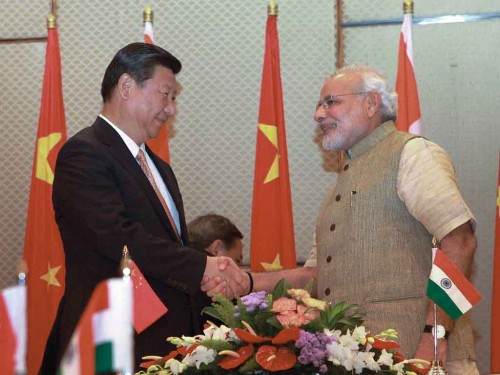Pramit Pal Chaudhuri, Hindustan Times, New Delhi
Updated: May 14, 2015 00:58 IST

Besides their formal meetings, Narendra Modi and Xi Jinping have also conversed on the phone. Modi’s conclusion is that while Xi is a difficult customer, he is a person one can do business with.
Xi has reasons to invest in a relationship with India.
The first is economic.
Xi has ambitious plans to reform the Chinese economy, recognising that the its present economic practice of over-investing in production capacity is reaching its limits. But he also has to ensure the existing economy doesn’t come crashing down.
So Xi is seeking alternate overseas markets for China’s huge steel, cement and materials sectors. Thus his One Belt, One Road and various Silk Route proposals, all designed to build infrastructure beyond China’s borders. Explains Columbia University’s Daniel Rosen, “Xi wants to stimulate demand for basic materials producers without further over-building domestic infrastructure.”
South Asia, a region marked by a paucity of infrastructure, is a perfect match.
Which is why Beijing has been trying to win over Modi. China’saAmbassador to India, Le Yucheng, calling India a “natural partner” for these programmes, has even offered to “link the Belt and Road initiatives with India’s Spice Route and Mausam projects.”
Jayadev Ranade of the Centre for China Analysis and Strategy says Xi’s “main push during the Modi visit will be to sell One Belt, One Road”. This is not just about contracts, it is crucial to Xi’s economic reforms.
The second interest is the border .
This is a thorny issue. Even with the best of intentions by Modi and Xi it will take years to resolve. However, just getting the talks, effectively stalled since 1985, moving again would be an accomplishment.
Australia’s ex-prime minister, Kevin Rudd, said earlier this year that Xi was prepared to offer new border terms. China, he argued, had sea boundary disputes running from Japan to Indonesia while its only disputed land border was with India-Bhutan. Beijing wanted to settle its land boundaries so it could focus on its coast.
M Taylor Fravel, MIT expert on China’s territorial policies, has argued Beijing prioritizes its maritime disputes because “islands are seen as possessing much more strategic, military and economic value”. China, he says, handles its India border much less aggressively than the way it handles the South China Sea.
China has informally communicated to India that since they now both have “strong leaders”, this was the opening to fix the border.
The third reason is the United States.
Modi, in issuing a vision document of the Asia-Pacific with the US, accepts that India has a US card to play against China.
Xi’s main goal, says Willy Lam of the Chinese University of Hong Kong, may be to “prevent India from joining a ‘coalition of values’ with the US, Japan, Australia and others feeling threatened by the dragon.” Indian diplomats who handled border negotiations say Beijing was most conciliatory when it believed Indo-US relations were strong.
Xi may want to work with Modi, but he will not make it easy. Said a senior US diplomat who handled China during the first Obama administration, “Whether you are friend or foe, dealing with Beijing is like riding a roller coaster.”